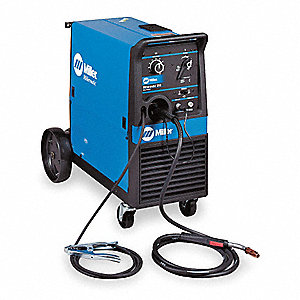Difference between revisions of "MIG Welder"
Jump to navigation
Jump to search
| Line 20: | Line 20: | ||
= Procedures: = | = Procedures: = | ||
| − | |||
| − | |||
Prior to Welding | Prior to Welding | ||
| Line 45: | Line 43: | ||
= Warnings: = | = Warnings: = | ||
| + | # Don’t weld lead, zinc, copper, cadmium, stainless, or beryllium. Welding these materials can be harmful if not equipped with proper safety gear and training. | ||
| + | # Don’t weld in wet gear or standing water | ||
| + | # Always turn gas and the welder off when you are done in the welding shop | ||
| + | # Never weld without a welding helmet | ||
| + | # Never weld without gloves | ||
| + | # Don't weld with the vent hood off | ||
| + | # Don't weld with the gas off | ||
| + | # Don't exceed gas pressure past specified value | ||
| + | # Don’t unscrew valve adjusting screw all the way out | ||
Revision as of 14:06, 11 February 2019
The Millermatic 210 is a wire feed welder that is meant for light industrial use. It uses 72/25 CO2 and Argon gas mixture to shield the molten weld from oxygen. If the weld pool is exposed to oxygen, it can create a handful of problems such as porosity and excessive spatter in the bead. This welder is capable of welding carbon steel as well as stainless steel.
Documentation
Procedures:
Prior to Welding
- Place the fume hood over the area you will be welding at
- Attach the ground clamp to the bench your workpiece will be on
- Ensure the workpiece is touching the conductive surface of the table
- Ensure the adjusting screw on the tank regulator is loose (Do not unscrew all the way)
- Open cylinder valve all the way
- Turn the adjusting screw (clockwise) to increase pressure to 15 CFH.
- Identify material type and thickness that is going to be welded
- Refer to MIG welding chart for specified adjustments, specific to your application
- Turn on the welder and adjust wire speed and voltage
- Ensure you are wearing all necessary protective gear
- Ensure the welding torch has proper amount of wire protruding from tip (about ¼ inch) If too long, trim excess with the welding pliers.
- Weld!
After Welding
- Close gas cylinder valve
- Bleed remaining gas by depressing trigger until regulator drops to 0
- Back out adjusting screw on regulator (Do Not unscrew all the way)
- Turn off the welder
- Remove ground clamp
Warnings:
- Don’t weld lead, zinc, copper, cadmium, stainless, or beryllium. Welding these materials can be harmful if not equipped with proper safety gear and training.
- Don’t weld in wet gear or standing water
- Always turn gas and the welder off when you are done in the welding shop
- Never weld without a welding helmet
- Never weld without gloves
- Don't weld with the vent hood off
- Don't weld with the gas off
- Don't exceed gas pressure past specified value
- Don’t unscrew valve adjusting screw all the way out
